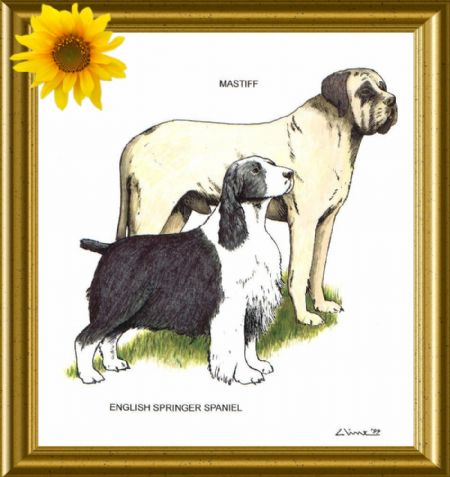RHEGED | The Springer On The 'Mayflower'

THE SPRINGER & THE PILGRIMS - PLYMOUTH, USA 1620:
In Mourt's Relation, (1622) Edward Winslow has left a record of at least 2 dogs who participated in the settling of Plymouth Colony. He tells us a Mastiff & a Springer Spaniel were involved in the first explorations of discovery on Cape Cod & the activities of the home building during the first winter ashore. Although there may have been other pets aboard 'Mayflower' during her historic voyage, they are not mentioned.
THE MASTIFF:
The breed of the dog properly described as the 'Old English Mastiff' is a giant short-haired dog with a heavy head & short muzzle. It has been bred in England for over 2,000 years as a watchdog. The Mastiffs were also referred to as 'bandogs' or 'tiedogs', meaning they were tied up during the day, but let loose at night. They were also used as hunting dogs by the nobility. They are powerful, agile & courageous dogs. Mastiffs were, & still are, very large dogs that stand from 27 to 30 inches high at the shoulders. The colour of the dogs runs from apricot to silver fawn & fawn brindle.
THE ENGLISH SPRINGER SPANIEL:
The Spaniel breeds have always been valued by hunters because of their inherent desire to hunt. This quality allows the dog to search the ground ahead of the hunter at a fast, snappy pace. However, the dogs must be trained to be under control at all times. Ordinarily trustworthy & adaptable, the Springer Spaniel has always been popular because of its love of home & family.
THE ACTUAL HISTORICAL RECORD:
The first indication of Pilgrim dogs being present comes during the second exploration of discovery (from November 30th, 1620 ~ December 10th, 1620). During that exploration, the group of men stumbled upon two Indian dwellings. In recounting what they found, we are told they found 2 or 3 pieces of venison thrust into a tree, which they thought “fitter for the dogs than for us.” The specific words “the Dogs” are significant in that they seem to indicate specific dogs & are not used in reference to dogs in general. This passing remark would seem to indicate John Goodman & his 2 dogs were with that group men.
On Friday, 12th ~ 22nd January 1620, John Goodman, aged about 25 & Peter Browne, also in his 20's, went out from the village accompanied by 2 other unnamed men to cut thatch for roofing on the houses. With the men were John Goodman's 2 dogs, the 'Mastiff' & the 'Spaniel'.
Having become lost, they had wandered all afternoon, cold & wet. The men sat down that evening to eat what little food they had with them. That evening, after eating their meager supply of food, they went for a walk & found a small lake. By the waterside was a large deer. The excited dogs chased after the deer with John & Peter following until they became lost.
The night was bitterly cold, frosty & snowy. Neither of the men was dressed for the bitter cold, & they had no bed but the cold ground. During the night they heard what they took to be 2 lions roaring in the woods & a 3rd nearby. Frightened, they climbed a tree for safety. However, it was bitterly cold & neither man was dressed for the extreme temperature. They descended to the ground where they walked about the tree all night. We are told they had to “hold the bitch by the neck to keep her from following the lion.” We are never told which of the 2 dogs was the female.
At first light on Saturday they traveled again until late afternoon, covering a distance they estimated to be about 5 miles. When the cold, hungry men finally limped into the village on Saturday evening, John Goodman had to have his shoes cut from his frostbitten feet because they were so swollen from the cold-causing him to be lame.
However, we are told John Goodman & the Springer Spaniel again ventured out of the village on 19th ~ 29th January 1620 because John “wanted to use his lame feet.” Nearby, they were met by 2 wolves who chased after the Springer Spaniel. The frightened dog ran between John's legs for safety. Having no weapon with him, John picked up a stick & threw it at the wolves, hitting one of them. Then with another stick in his hand, he stood watching the wolves with the frightened Springer Spaniel cowering between his legs. The wolves sat down at some distance, seeming to grin at them, & watched the pair for a while; then, losing interest, wandered away.
John Goodman sadly died that first winter & we have no record of what became of the 2 dogs, but surely one of the surviving colonists took them in & cared for them?
